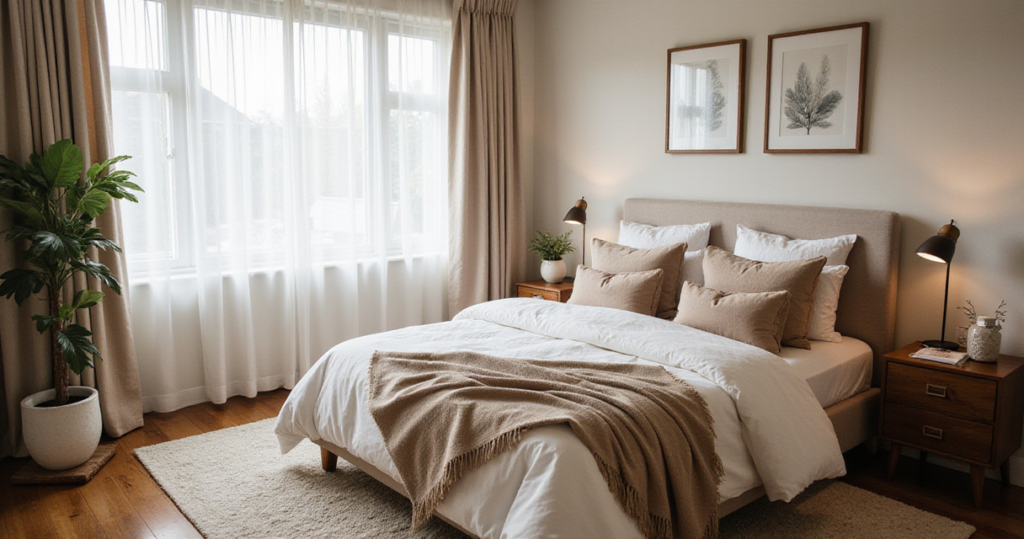A bedroom is more than a place to sleep. It is the space that holds you at your most vulnerable—at the beginning and end of each day. To shape this room is to invest in your own peace, a practice of care that extends into every part of your life. The art of the bedroom is a quiet one, a balance of aesthetics and function, of sensory comfort and personal meaning. In Japanese design, we have a deep respect for this balance.
We speak of rooms that can breathe. This comes from an understanding of ma, the profound power of negative space. It is not about having less, but about allowing each object the space to have meaning. This philosophy asks for quality over quantity, for materials that tell a story, for colors that soothe the spirit. Let us explore how this way of thinking can help you shape your own sanctuary.
1. Begin with Stillness, Not with Plans
Before a single object is moved, before a color is chosen, the true work begins. It starts with stillness. Resist the urge to fill the space with trends you have seen. Instead, spend time in your current bedroom and simply observe. How does the morning light travel across the floor? Where does your eye land when you feel tired or tense? This is not about planning in the typical sense; it is about listening.
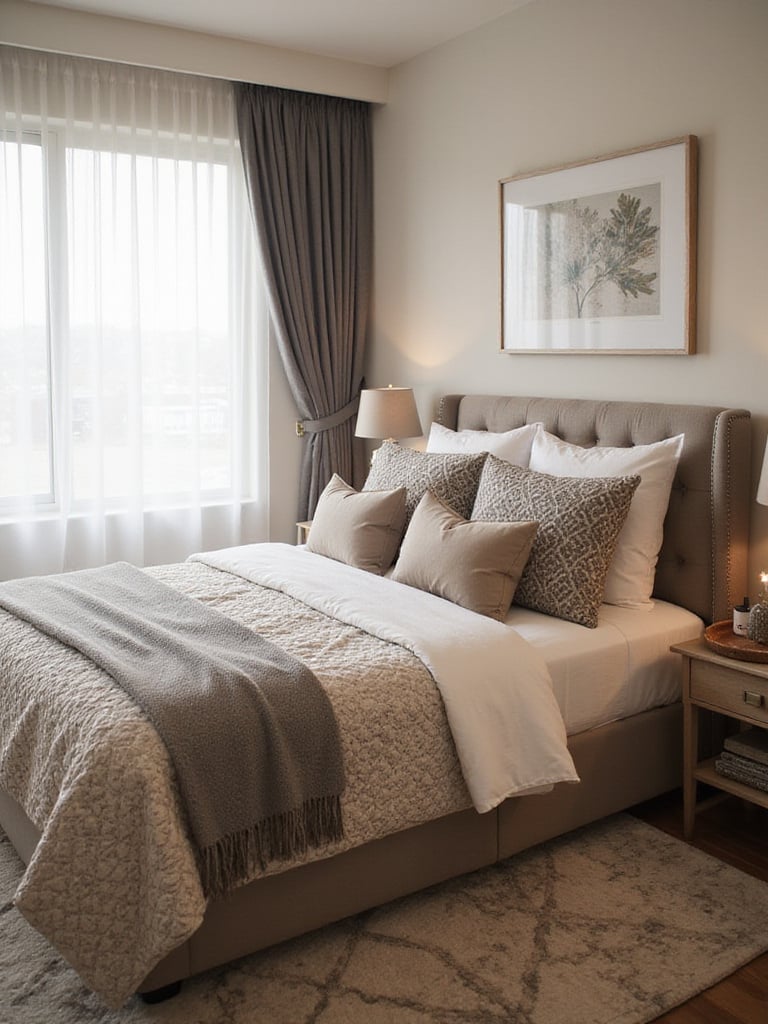
I once worked with a client in a bustling city apartment who was convinced he needed a dark, “cocoon-like” bedroom to escape the noise. But after a week of simply sitting in the room for ten minutes each morning, he realized what he truly craved was the gentle, unobstructed light from his east-facing window. We reoriented the entire room around that single observation. His vision shifted from hiding from the city to welcoming the quietest part of its day. The most satisfying designs arise from this kind of honest reflection, where every choice feels authentic to you.
Your resources, like your attention, should be guided by this new understanding. Invest in the elements that will most deeply affect your sense of well-being, whether it is the feel of the floor under your bare feet or the quality of the air you breathe.
2. Harmonize the Flow of Movement
In traditional Japanese architecture, we pay close attention to circulation—the way people and energy move through a room. A bedroom’s layout should feel effortless, with clear, generous pathways that allow you to move with an unthinking grace, even in the half-light of dawn. This prevents a subtle, daily friction you might not even notice you’re experiencing.
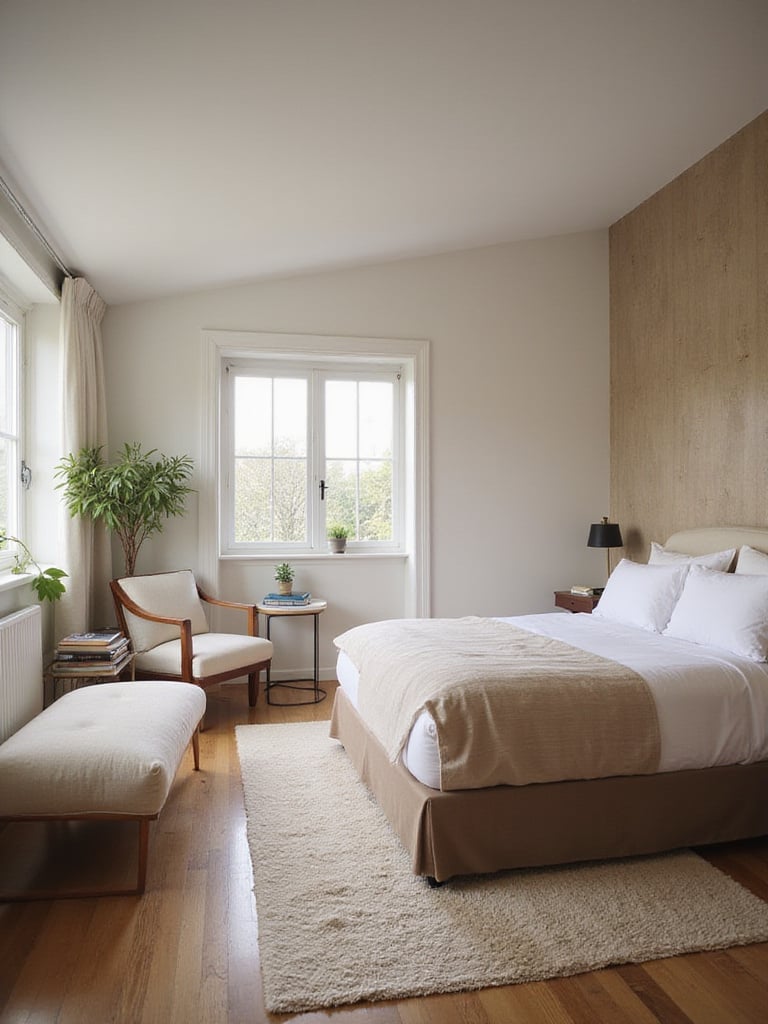
The bed is the anchor, the point of stillness around which the room’s energy flows. Its placement is critical. Think about the first thing you want your eyes to rest upon when you wake. Is it a clear view of the sky? A beloved piece of art? Position your bed not just for convenience, but for this first, gentle moment of daily connection. Storage should feel integrated, like a natural part of the walls, creating clean lines that guide the eye peacefully around the room.
- Measure your room, but also feel it. Walk the paths you take daily.
- Allow enough space around the bed to feel generous, not merely sufficient.
- Position the bed to greet the morning light softly, avoiding harsh glare.
- Consider the view from your pillow; it is the first canvas of your day.
Every element should support this natural, easy rhythm, creating a space that feels calm because it is fundamentally in tune with your movements.
3. Evoke Atmosphere with Whispering Colors
The color in a bedroom should be a whisper, not a shout. It is there to create a serene envelope that quiets the mind and prepares the body for rest. The most harmonious palettes are often drawn from the subtle colors of the natural world: the grey of a misty morning, the warm, complex beige of sand, or the deep, restful green of a forest floor. These colors resonate with our innate circadian rhythms.
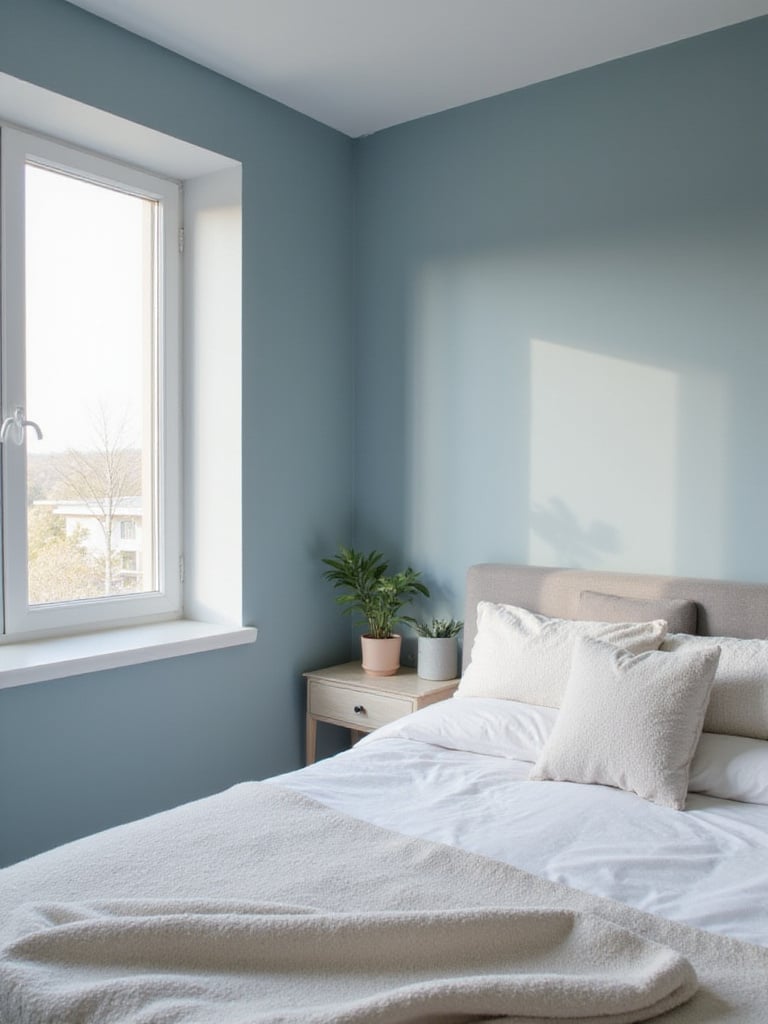
Light and color are in a constant dance. A color that feels calming at noon may feel draining at dusk. This is why observing paint swatches on your own walls, in your own light, is so important. natural materials are your best storytellers here. A simple plank of hinoki wood contains a whole spectrum of warm tones; a wall of earthen plaster holds shadows in a way that flat paint never can. These materials bring a richness and complexity that feels alive.
When you layer these quiet tones with varied textures, the room gains a visual weight that feels both grounded and deeply comforting.
4. Layer Light for a Living Environment
Light is not a single utility; it is the soul of the room, and it must serve many moods. Your bedroom is a space for reading, dressing, quiet contemplation, and, of course, deep sleep. A successful lighting plan acknowledges this by layering different sources—ambient, task, and accent—giving you complete control over the environment.
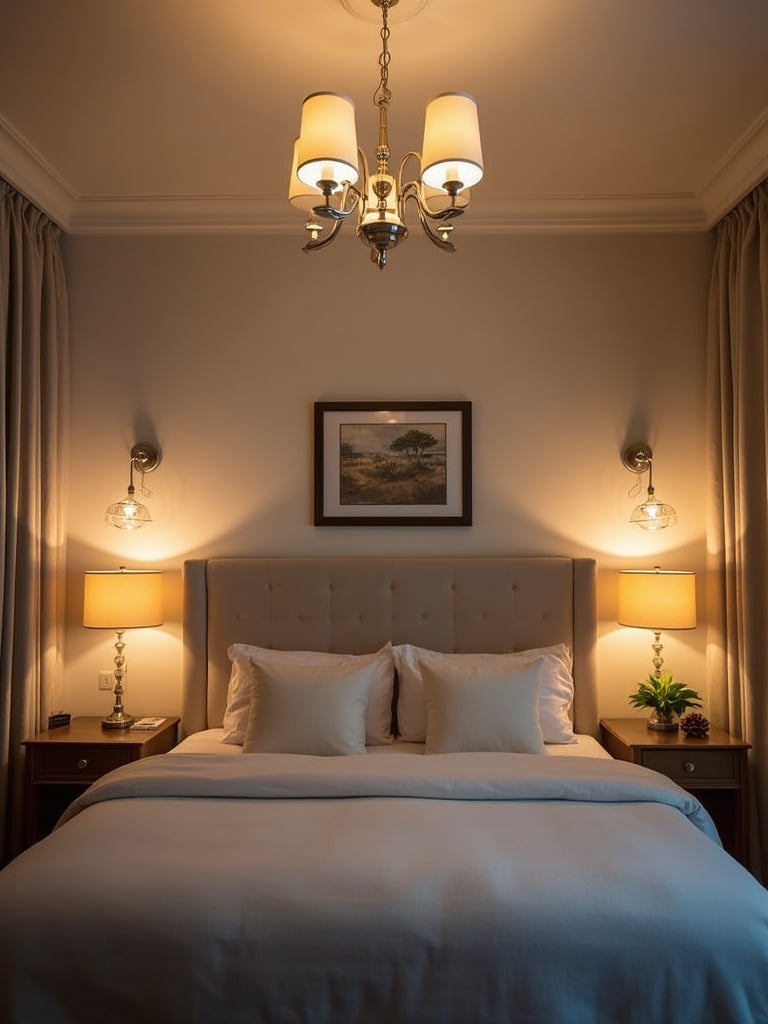
The temperature of light is just as vital as its brightness. A warm, soft light (around 2700K) in the evening supports your body’s natural production of melatonin, signaling that it’s time to wind down. In contrast, a brighter, slightly cooler light in the morning can provide focus for your early routines. This is where dimmer switches become your most valuable tool, allowing you to fine-tune the atmosphere.
- Install dimmers on every light source. It’s a non-negotiable for creating a responsive space.
- Choose warm-toned bulbs (2700K-3000K) for all evening illumination.
- Place task lighting, like a reading lamp, so it illuminates without creating distracting glare.
- Consider smart lighting that can be programmed to shift its temperature and intensity with the time of day, effortlessly aligning with your body’s needs.
The lighting should feel as though it’s evolving with you throughout the day, a seamless and supportive part of your environment.
5. Filter the Day with Purposeful Window Treatments
The way light enters your room from the outside has a profound effect on your sleep and your mood. Window treatments are not just decoration; they are the guardians of your sanctuary. They must provide absolute darkness for restorative sleep but also be flexible enough to welcome the day’s gentle light when you are ready.
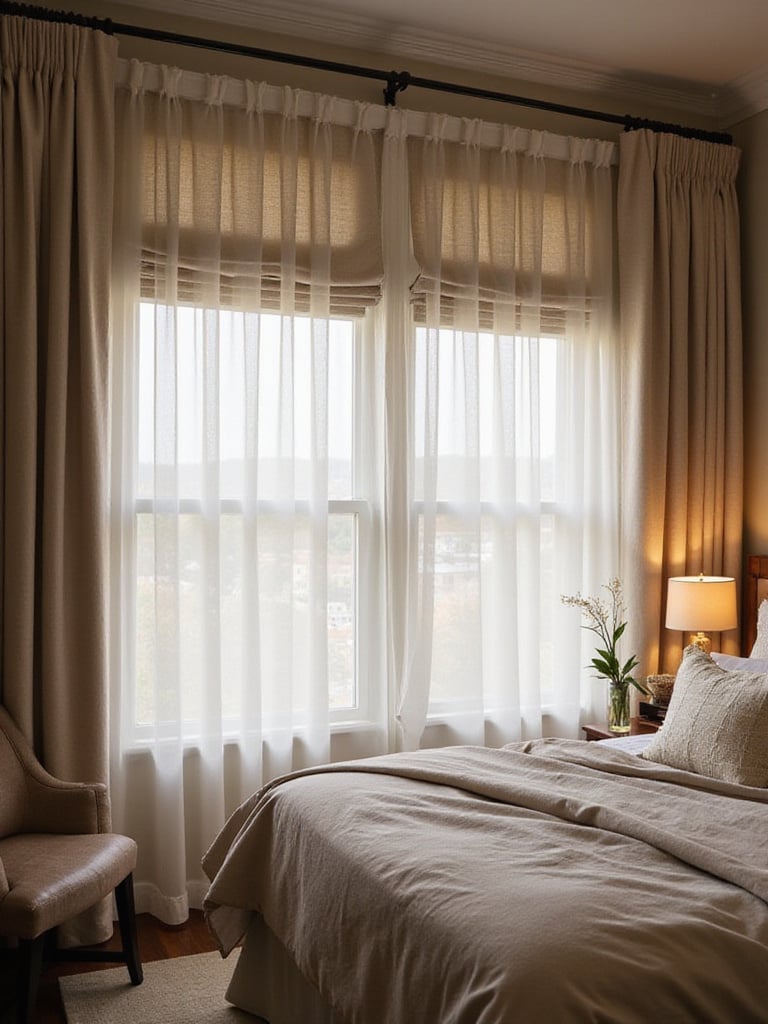
Here, layers are once again your friend. A sheer inner layer can diffuse harsh daylight into a soft glow, while an outer layer of blackout material can provide the complete darkness necessary for healthy sleep. I often suggest natural fabrics like linen or cotton. Their organic texture complements a tranquil aesthetic, and they filter light in a way that feels softer and more natural than synthetic options.
- Extend curtain rods well beyond the window frame. This makes the window feel larger and blocks more light.
- Layer a sheer panel for daytime privacy with a heavyweight curtain for darkness.
- Choose natural materials that echo the other textures in your room.
- Motorized shades, once a luxury, are now an incredible tool for convenience and can be programmed to open gently as you wake.
This approach allows you to control light without feeling disconnected from the natural world outside.
6. Integrate Storage that Recedes from View
In a tranquil bedroom, storage should be felt, not seen. The goal is to create a sense of calm by eliminating visual noise, ensuring that everything has a place to rest quietly. This is where integrated, built-in solutions become invaluable. By blending seamlessly with the architecture, they don’t demand attention.
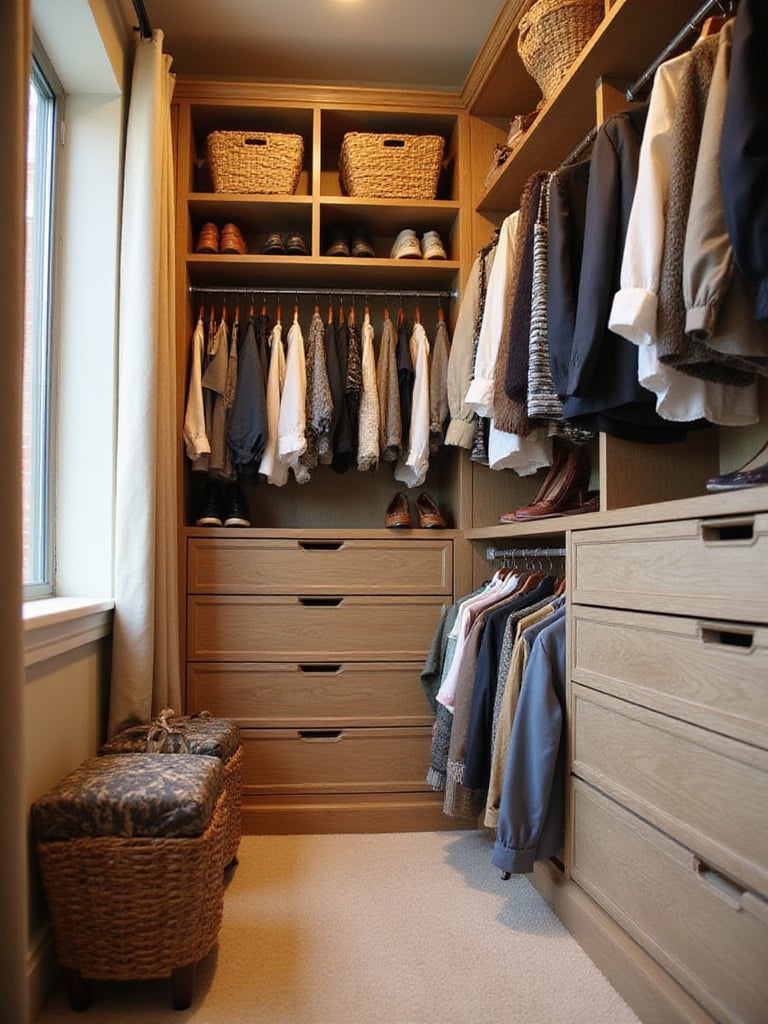
Think vertically. Use the full height of your walls for storage, keeping the things you use daily within easy reach and seasonal items higher up. In my experience, custom storage designed for your specific needs is one of the wisest investments in a remodel. It isn’t just about efficiency; it’s about creating a sense of deep, uncluttered order that translates directly to a calmer mind.
The true benefit is not just in tidiness, but in choosing quality pieces that will serve you for decades, a sustainable choice that honors both your home and the environment.
7. Define Zones for Ritual and Rest
Even the smallest bedroom benefits from the creation of distinct zones. You don’t need walls; you just need subtle cues that delineate the space for sleeping from the area for dressing or a quiet corner for reading. A shift in lighting, a small rug, or even a different wall texture can create these psychological boundaries. This brings a sense of purpose and order to the room.
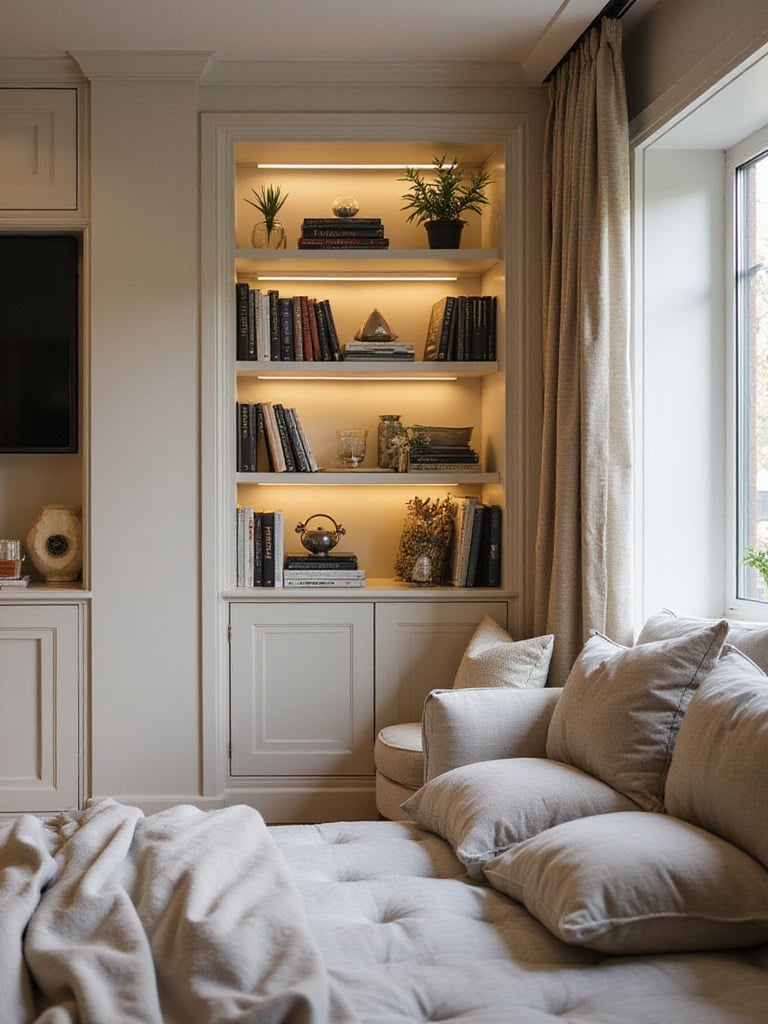
The sleeping area should feel like the most sacred and protected part of the room, perhaps with softer textures and more intimate lighting. A small corner with a comfortable chair and a good reading lamp becomes a dedicated space for winding down, signaling to your brain that this is a place for contemplation, separate from sleep. The transitions between these zones should feel gentle and intuitive.
I’ve noticed that people often try to cram too many functions into a space without creating these subtle distinctions. The result is a room that feels chaotic because nothing has its own place.
8. Choose Flooring That Quiets the Room and the Mind
The floor is the foundation of the room’s sensory experience. It affects not only how the room feels underfoot but also how it sounds. Natural materials like hardwood, cork, or bamboo bring a warmth and organic beauty that cannot be replicated. Their subtle imperfections and grain patterns add a layer of quiet visual interest.
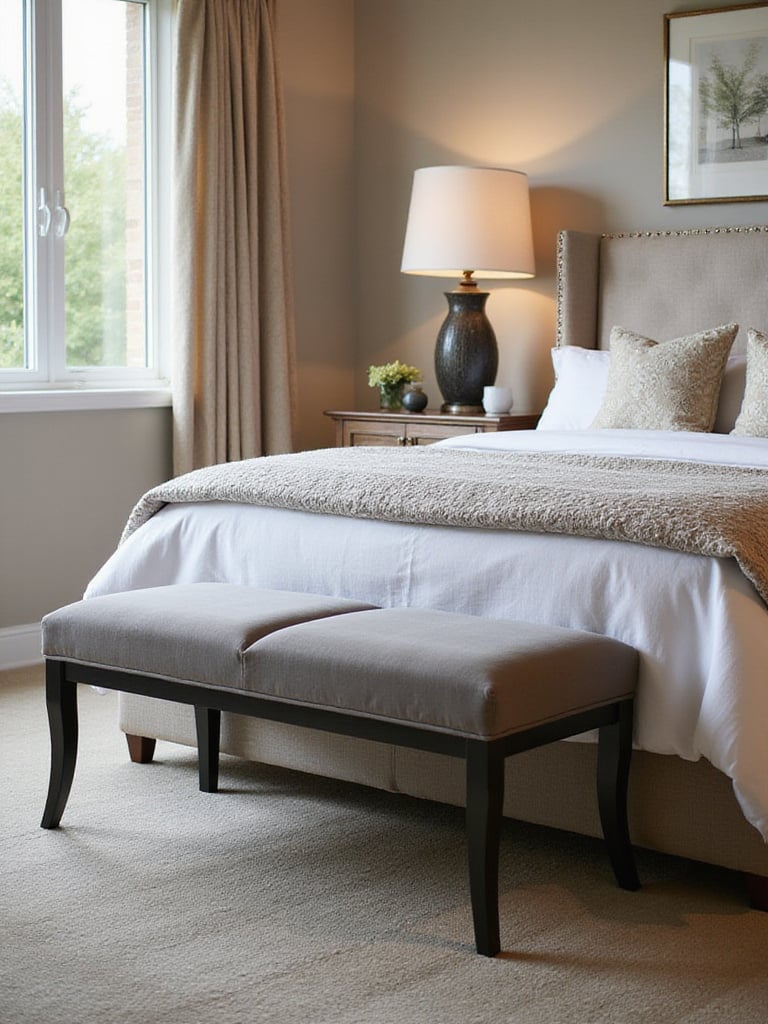
Think about the sound in the room. Hard surfaces can create an echo, a sense of emptiness that can feel unsettling. Soft materials absorb sound, contributing to a feeling of tranquility. An area rug is a powerful tool here. It can define a zone, add warmth, and muffle sound. Its placement is key—a rug that’s too small feels like an afterthought, while one that’s too large can swallow the room.
And beyond how it looks or feels, the flooring you choose impacts the air you breathe. Selecting natural, low-VOC materials is an investment in your long-term health.
9. Invest in the Surfaces That Support Your Sleep
Of all the elements in your bedroom, the mattress is the most crucial investment in your health. A quality sleep surface that supports your body and relieves pressure is fundamental to restorative rest. Frankly, this is not the place to compromise. The right choice depends on a very personal equation of your body, your sleep style, and your comfort.
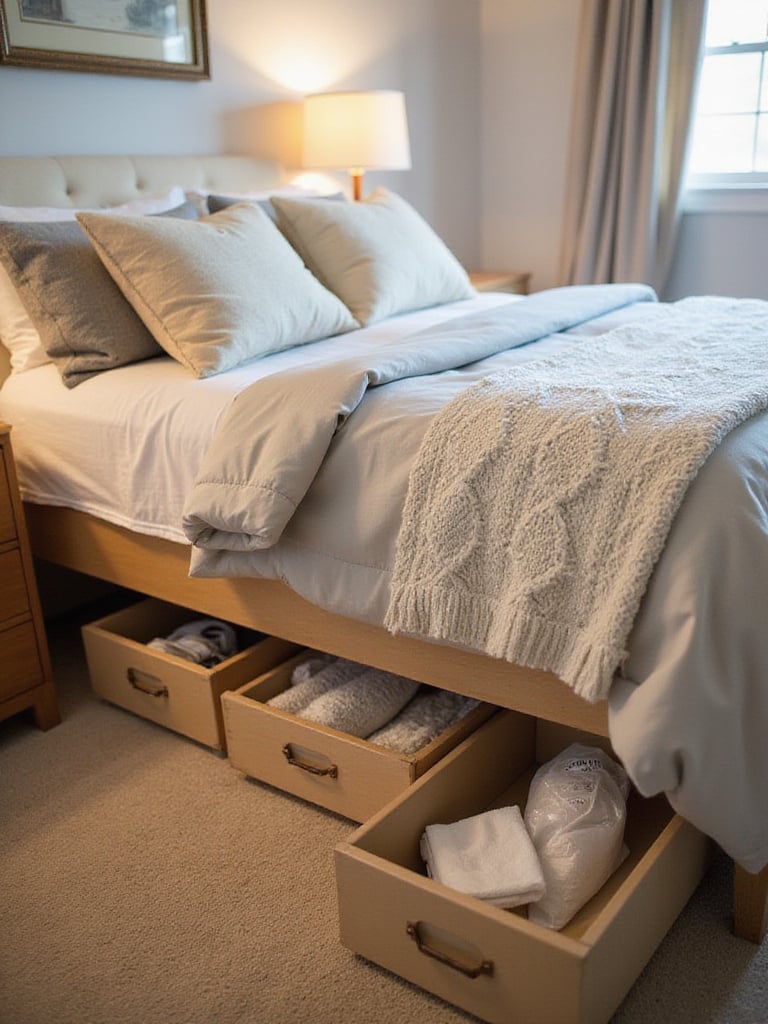
But the mattress is only one part of the system. The foundation, your pillows, and your bedding all work in concert. I always advocate for natural, breathable materials like organic cotton, wool, or linen. They help regulate your body temperature and don’t introduce synthetic chemicals into your sleep environment. An investment in these surfaces is a direct investment in your energy and well-being for years to come.
You will feel the difference not on the first night, but years from now, when a quality mattress still offers the same support and comfort.
10. Layer Textiles for a Rich Sensory Experience
Textiles bring the human touch to a room. They introduce warmth, softness, and an opportunity for subtle pattern and color. The real artistry lies in mixing different textures to create a rich, tactile experience. Think of the smoothness of a percale sheet against the nubby texture of a linen duvet, or the softness of a wool throw. These contrasts invite touch and create depth.
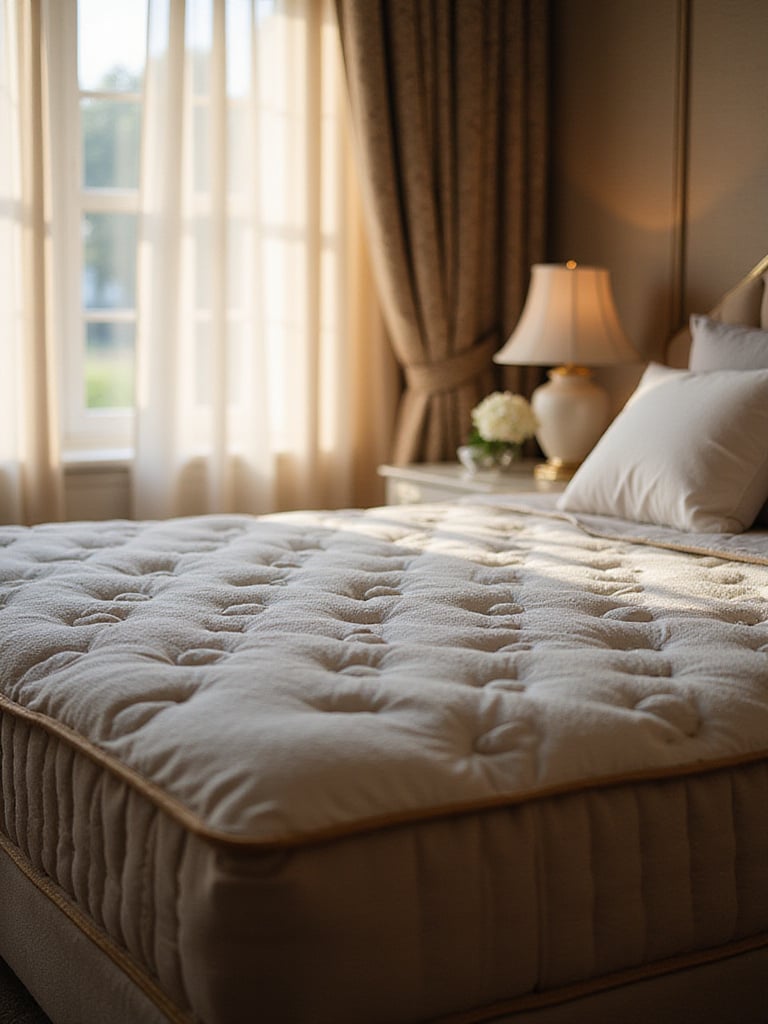
This layering should feel natural, not overly styled. Each piece should have a purpose, whether it’s the warmth of a quilt or the comfort of a supportive cushion. Textiles are also your chance to introduce change with the seasons. A heavier wool blanket in winter can be swapped for a light cotton throw in summer, keeping the room feeling responsive and alive.
- Aim for at least three different textures in your bedding alone.
- Stick to natural fibers; they breathe better and feel better against the skin.
- Vary the scale of any patterns, balancing a larger design with smaller, quieter ones.
- Simply running your hand over natural versus synthetic fibers will tell you everything you need to know about quality.
This layering of textures creates a room that feels complete and deeply inviting.
11. Purify Your Environment for Deeper Restoration
The quality of the air in your bedroom has a direct impact on your sleep and overall health. An easy and beautiful way to start is with plants. They are living sculptures that naturally filter the air. Some, like the humble snake plant, are particularly suited for bedrooms because they release oxygen at night.
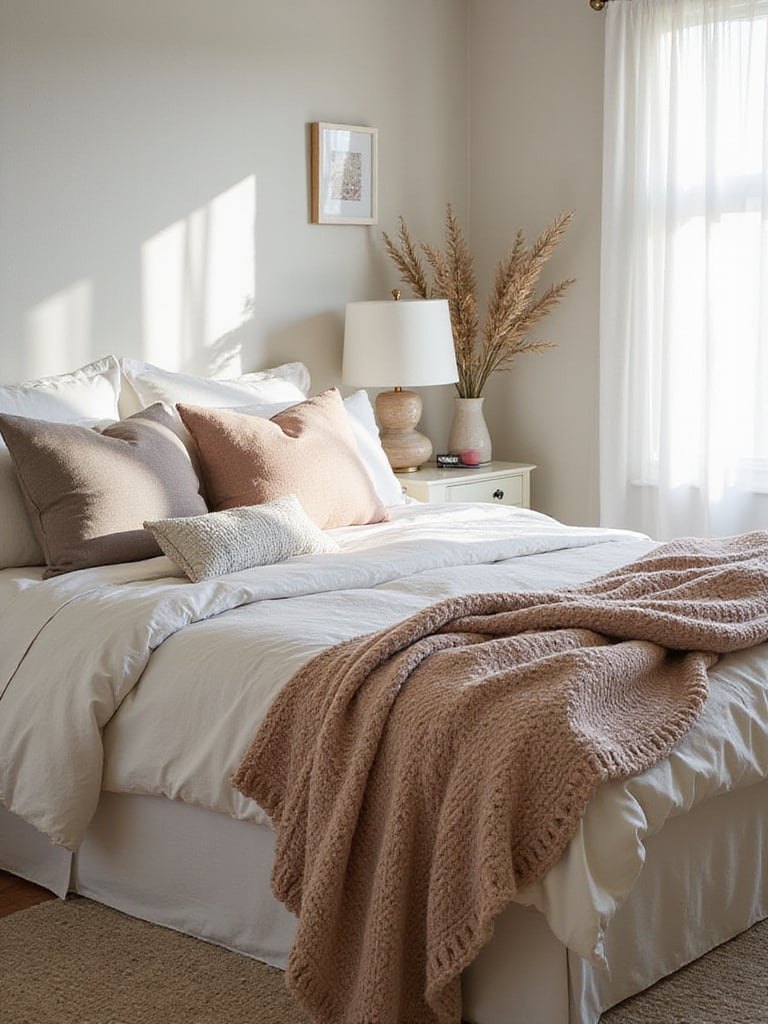
Beyond plants, you might consider a high-quality air purifier to remove airborne allergens and the volatile organic compounds (VOCs) that can off-gas from new furniture or paint. Proper ventilation is also key, ensuring a steady supply of fresh air. Your bedroom should be a place where your body can fully focus on its nightly work of healing and restoration, and clean air is essential for that process.
When you begin to think about how your environment affects your body, you make design choices that support your health in profound ways.
12. Muffle the Outside World for Inner Peace
A truly restful bedroom is a quiet one. For many of us, especially in busy cities, sound control is essential. Soft materials are natural sound absorbers—think heavy curtains, upholstered headboards, area rugs, and even textiles hung on the wall. They all work to dampen noise and prevent echo, creating a more peaceful acoustic environment.
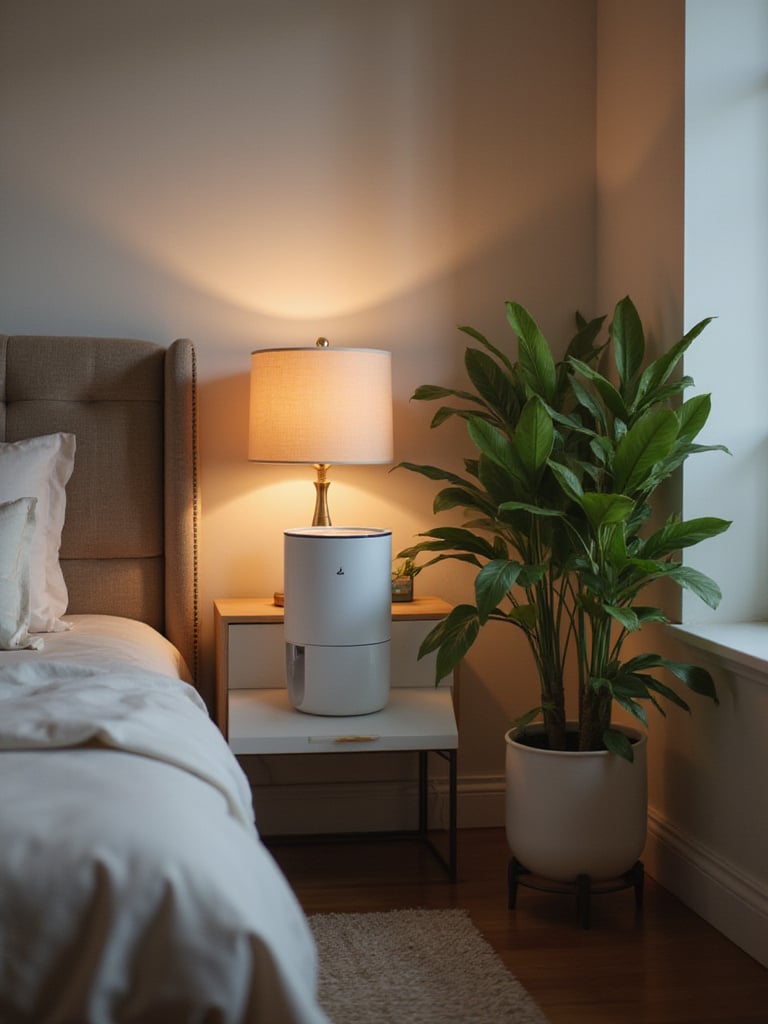
If outside noise is a significant issue, you may need to look at more architectural solutions, such as installing double-paned windows or adding insulation. But don’t underestimate the power of masking sounds. A white noise machine or a device that plays gentle nature sounds can cover up jarring, intermittent noises with a consistent, soothing hum that helps the brain disengage and slip into deep sleep.
The challenge is often in finding the balance between visual and acoustic comfort. Addressing both at the same time leads to a more holistically serene space.
13. Integrate Technology So It Disappears
Technology can either be a source of stress or a tool for serenity in the bedroom. The key is to integrate it so thoughtfully that it disappears into the background. The goal is support, not intrusion. For instance, an automated lighting system that gradually dims in the evening and brightens in the morning can work in harmony with your body’s natural rhythms.
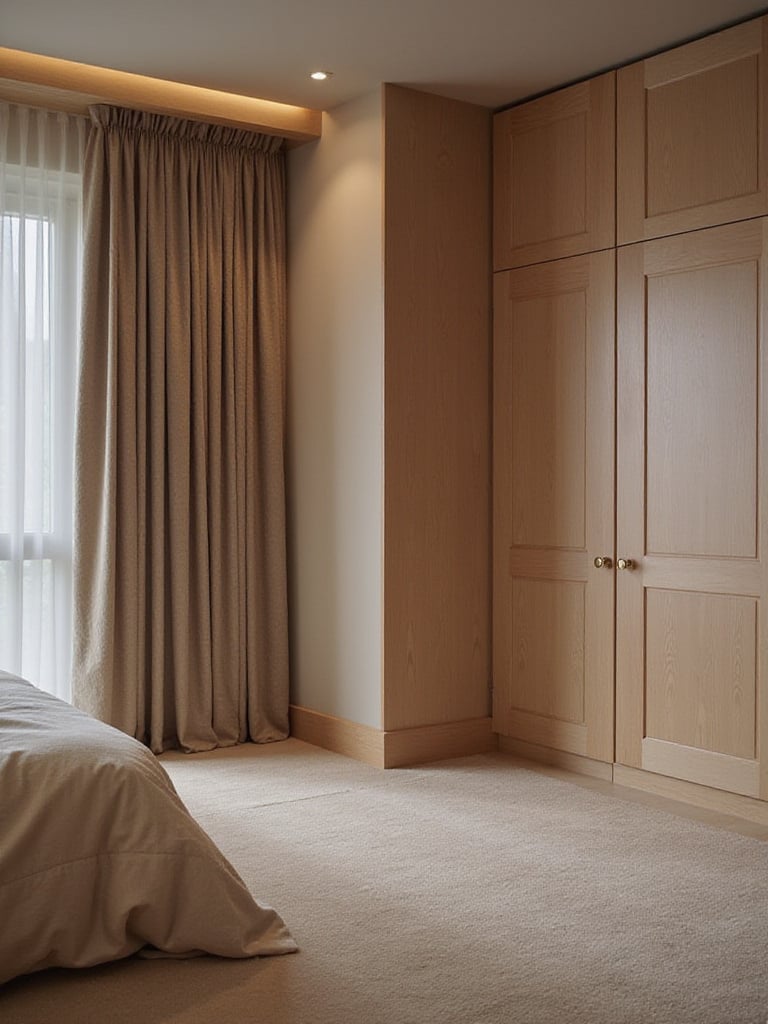
Voice controls can allow you to adjust the temperature or turn off a light without the stimulating blue light of a phone screen. Technology should serve your desire to disconnect. It shouldn’t be another thing demanding your attention. What I’ve found works beautifully is this unexpected pairing of cutting-edge tech with traditional, natural materials—like a smart thermostat that blends into a wall of natural clay plaster.
When technology serves your well-being instead of distracting from it, it has earned its place in your sanctuary.
14. Carve Out a Small Space for Contemplation
Even a small bedroom can hold a corner dedicated to quiet. It doesn’t need to be grand. A comfortable chair placed by a window, a single cushion on the floor, or a small built-in bench can become a powerful retreat within your retreat. It’s about creating a space that formally invites you to pause.
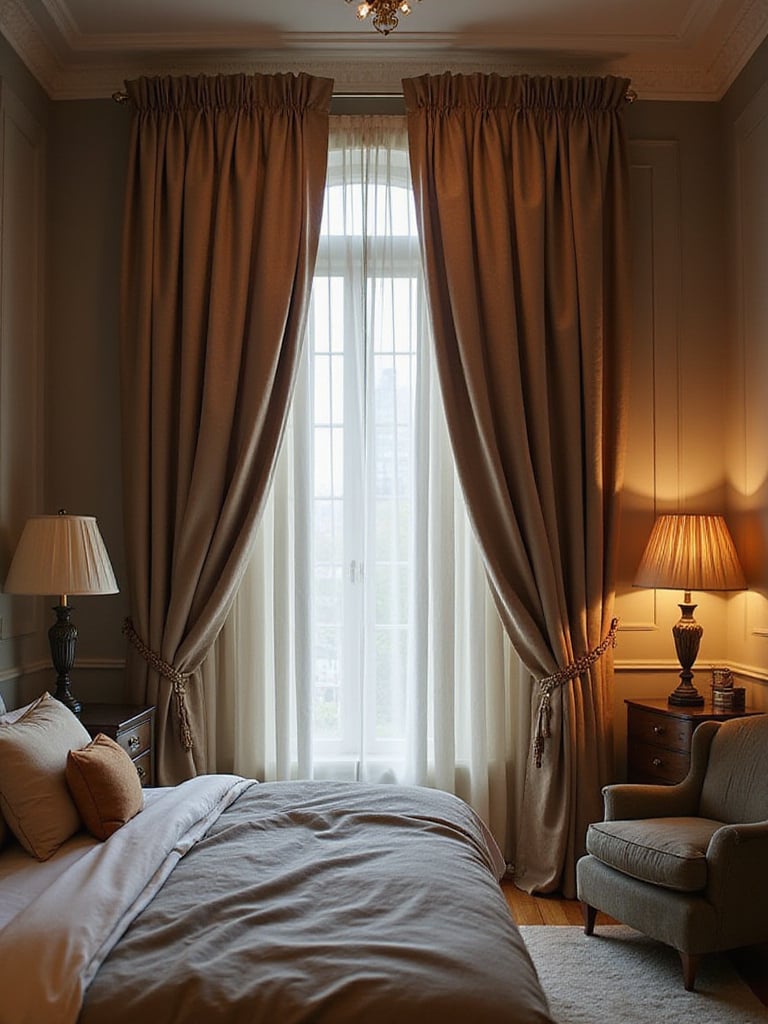
This small zone should have its own dedicated lighting—perhaps a focused lamp for reading that can be dimmed for meditation. The goal is to create a spot that feels psychologically separate from the rest of your daily life, a place to reconnect with yourself before beginning or ending your day. Just picturing that quiet corner can have a calming effect, a reminder that peace is always accessible.
This simple act of creating a dedicated space for ritual can profoundly change how you experience your home.
15. Create Calm by Subtracting Visual Noise
Simplicity in design is not about what you remove, but what you allow to remain. Eliminating visual clutter is essential for a tranquil bedroom because it directly supports a calm and clear mind. This doesn’t mean living in a sterile, empty box. It means that every object visible to the eye should be there for a reason—either for its function or for the genuine joy it brings you.
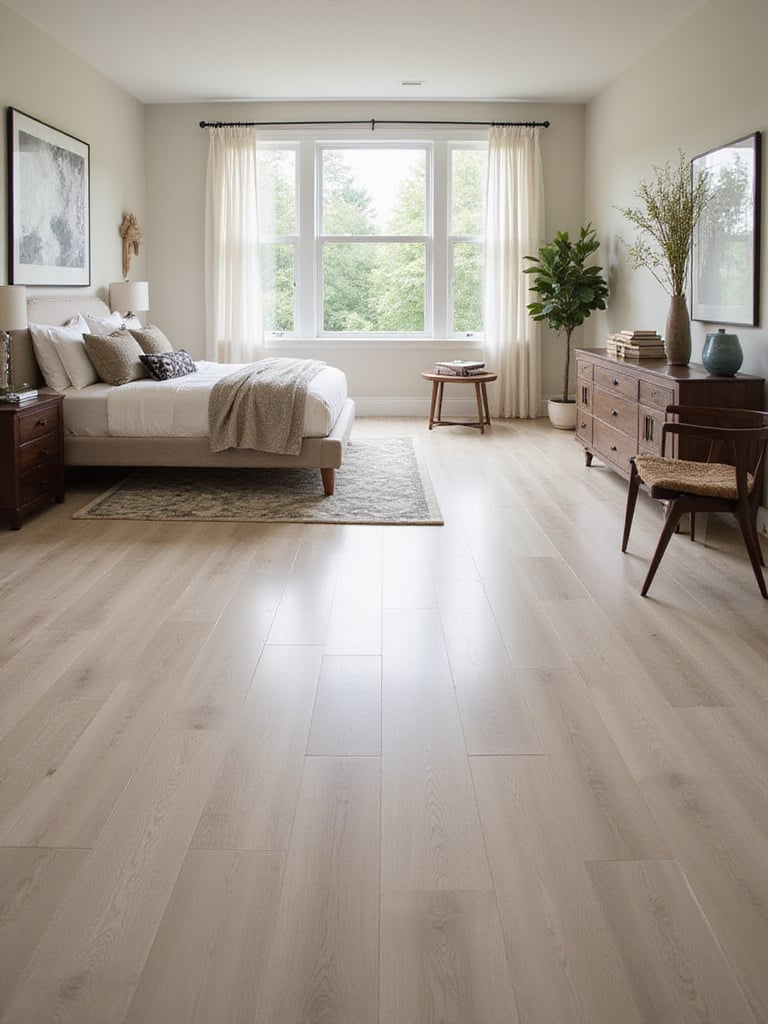
This is where the Japanese concept of ma, or the beauty of empty space, becomes so vital. Think of it as giving your furniture and beloved objects room to breathe. That space around them is just as important as the objects themselves. It prevents the eye from becoming overwhelmed and allows for a sense of peace to settle in the room.
- Limit what’s on display to only the most essential or meaningful items.
- Use beautiful closed storage to give necessary but less aesthetic items a quiet home.
- Create clear space around furniture. Don’t crowd things together.
- Practice a regular, gentle edit of your belongings.
The room finally comes into balance when you honor the space as much as you honor the objects within it.
16. Select Furniture with a Story to Tell
The furniture in your bedroom should feel like it has its own quiet history, or at least the promise of a long future. Choose pieces that are well-crafted from honest materials. A solid wood bed frame or dresser will only become more beautiful with age as it develops a rich patina from years of use and care. This is the essence of wabi-sabi: finding beauty in the imperfections that come with time and use.
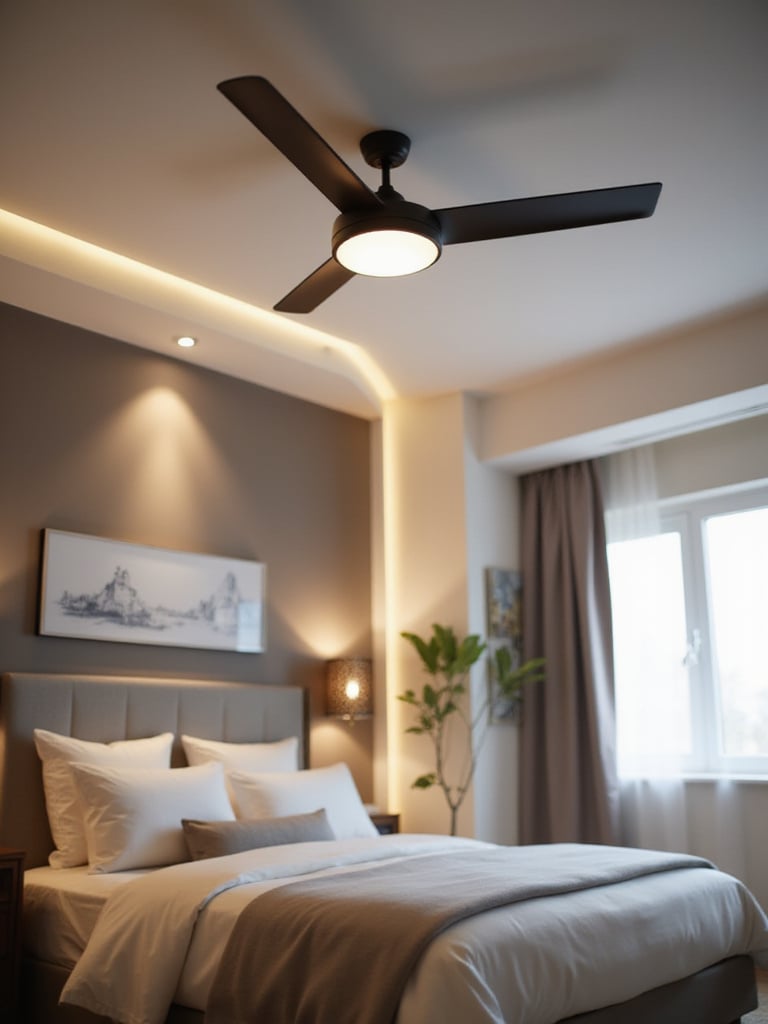
Pay attention to scale. The furniture should feel grounded in the room, substantial but not overwhelming. And look for timeless forms rather than passing trends. Investing in quality construction—things like solid joinery and hand-applied finishes—means you are choosing pieces that will not only last but will enrich your space for a lifetime.
These traditional methods result in furniture that doesn’t just wear out; it wears in.
17. Bring in Natural Elements to Stay Grounded
We have an innate connection to the natural world, and bringing elements of it into our most personal space is deeply grounding. Materials like wood, stone, and natural fibers provide a tactile richness that synthetic materials simply cannot replicate. A single, beautiful stone on a windowsill or a branch in a simple vase can serve as a powerful anchor to the world outside.
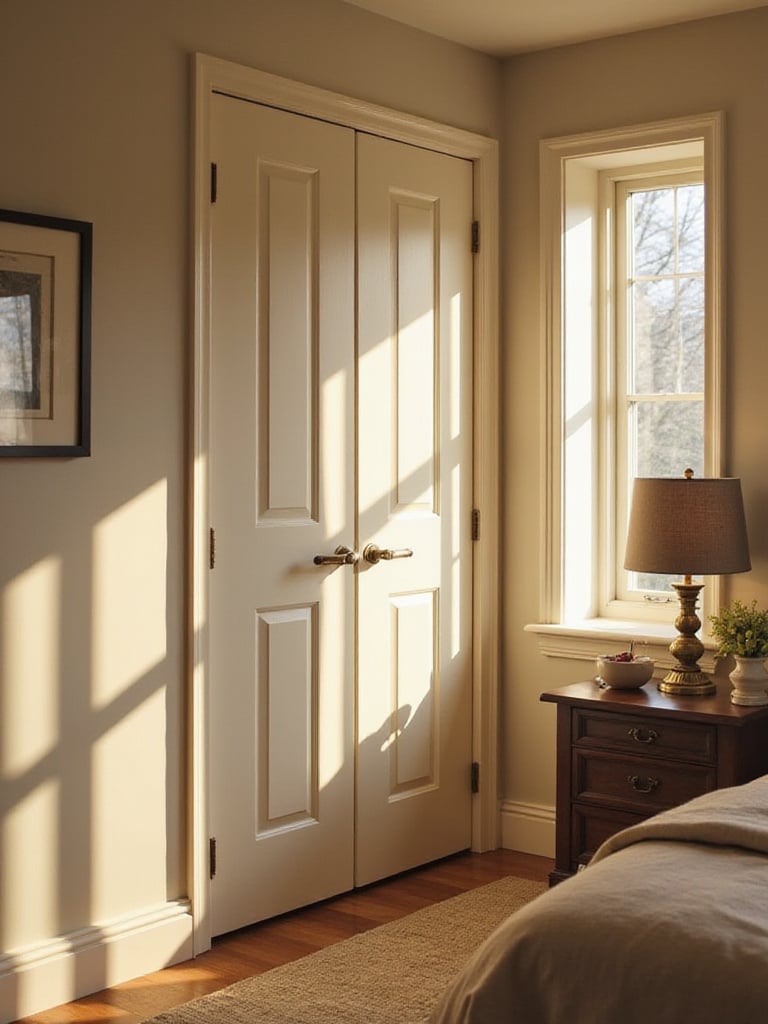
Consider how light interacts with these materials. Watch the way morning sun grazes across the grain of a wooden floor or how the soft light of evening warms the texture of a stone. These moments of beauty are fleeting and precious. By incorporating natural elements, you invite these quiet, daily performances into your room, keeping you subtly connected to the rhythms of nature.
Sourcing materials that are harvested and crafted with respect for the environment adds another layer of meaning to the objects you live with.
18. Design Your Lighting for Circadian Health
To design your lighting thoughtfully is to support your body’s most fundamental rhythm: the sleep-wake cycle. Our bodies are incredibly sensitive to light. Bright, cool-toned light in the morning signals that it’s time to be alert and energetic. As evening approaches, warm, dim light tells the body it’s time to produce melatonin and prepare for restorative sleep.
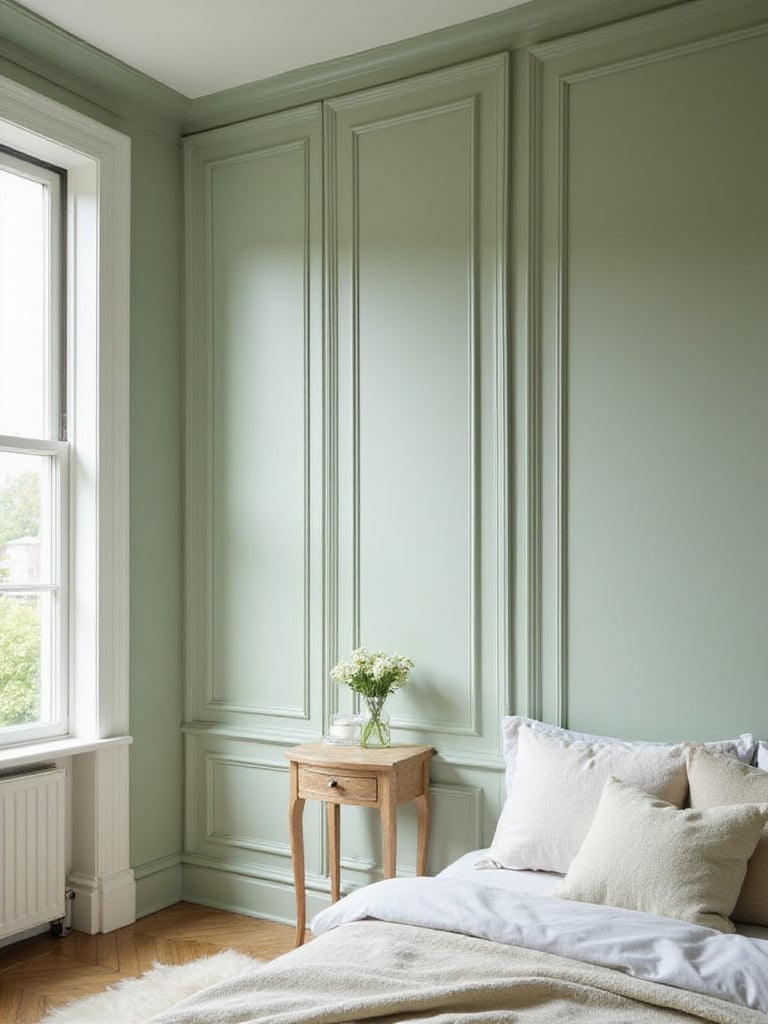
This is why the blue light from screens is so disruptive before bed. It sends the wrong message. The most health-conscious bedroom lighting designs work with these natural cycles, not against them. Smart lighting can automate this transition, shifting from cool to warm throughout the day without you even noticing. It’s one of the most powerful ways to use technology to support your biological well-being.
The entire mood of a space transforms when the lighting honors your body’s innate wisdom.
19. Build in Adaptability for the Seasons
Your bedroom should comfort you throughout the entire year, adapting gracefully to the changing seasons. The needs of a warm summer night are very different from those of a cold winter morning. Layering is the key to this adaptability.
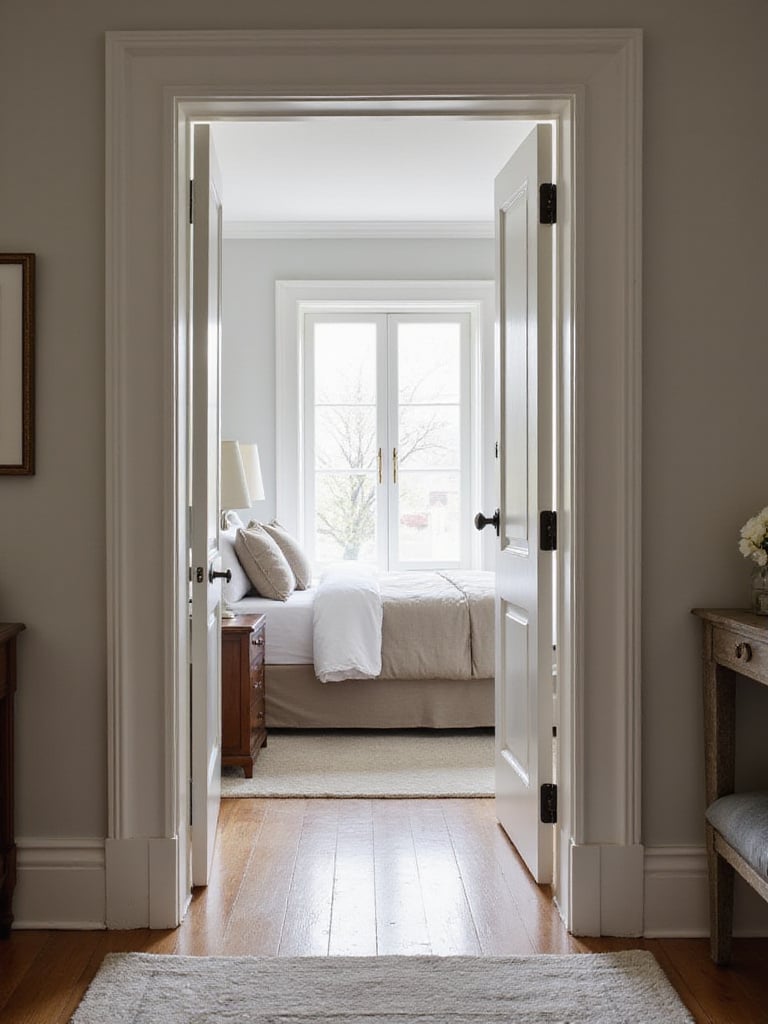
Bedding is the most obvious place to start. A collection of light cotton sheets, a mid-weight linen duvet, and a heavy wool blanket allows you to create the perfect combination for any temperature. But you can also think about smaller textile swaps—a change in cushion covers or a different throw can shift the feeling of the entire room. Thoughtful storage for these off-season items is important, keeping them accessible but out of sight.
The goal is to create a space that feels constant in its tranquility but can evolve with the rhythm of the year.
20. Establish Boundaries for Your Digital Life
For your bedroom to be a true sanctuary, it needs to be protected from the endless demands of the digital world. This requires establishing clear, intentional boundaries. It can be a simple rule, like no screens in the bedroom an hour before sleep, or a physical one, like creating a charging station for all devices in another room.
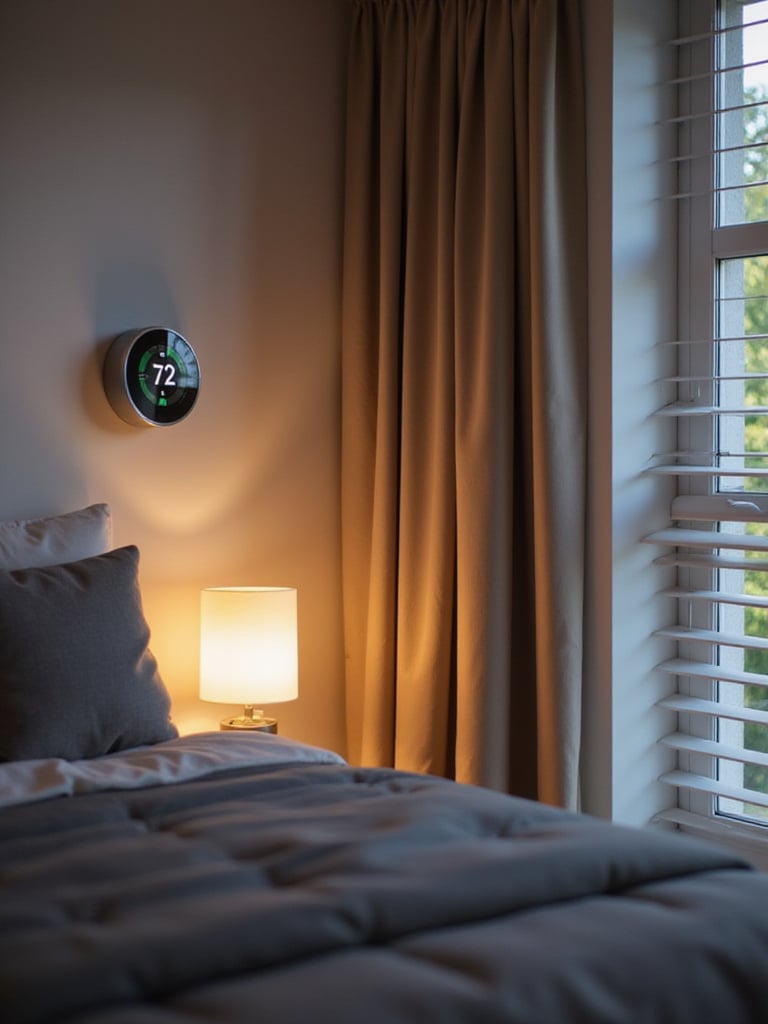
If technology must be present in your bedroom, choose options that support rather than hinder rest—like air purifiers with quiet operation or sound machines that mask disruptive noise. The bedroom should feel like a sanctuary from the constant connectivity of modern life.
When clients ask us about balancing style with comfort, we emphasize the importance of creating spaces that support disconnection and rest.
21. Honor Personal Rituals and Routines
Your bedroom design should support the personal rituals that help you transition between wakefulness and sleep. This might mean creating space for meditation, reading, or gentle stretching. Consider how your evening and morning routines flow through the space and ensure the design supports rather than hinders these important practices.
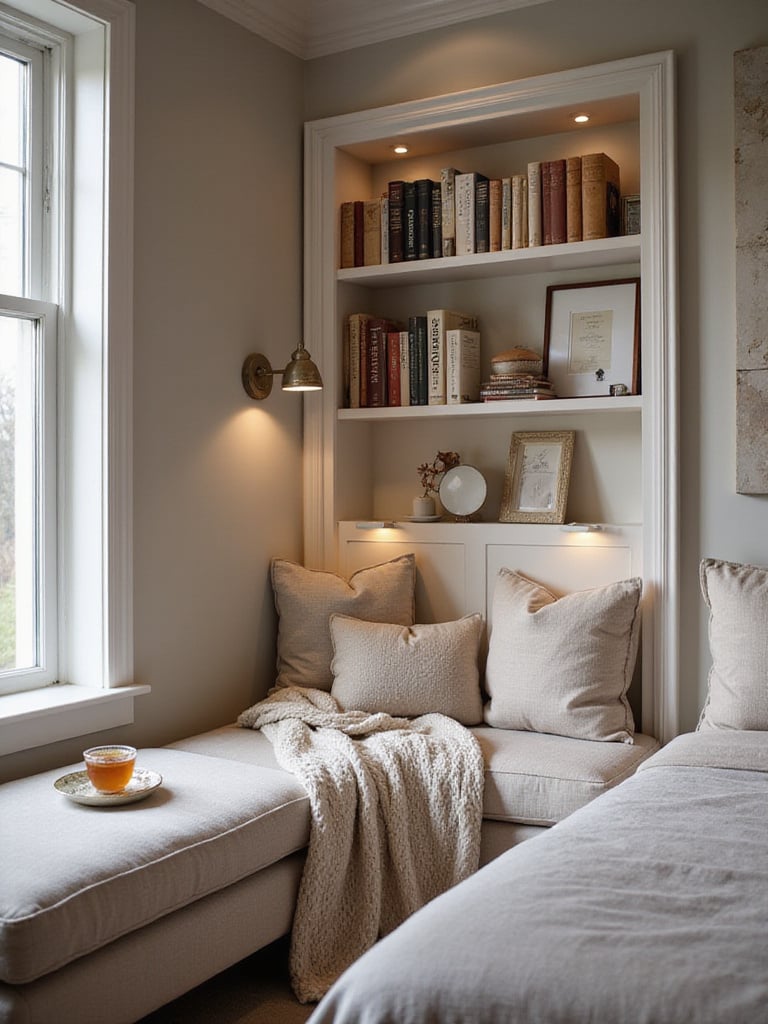
hink through your evening and morning routines. Does the layout support them? Is there a clear surface to place your book and a cup of tea? Is the light in your dressing area clear and flattering? When the design flows in harmony with these personal habits, the room becomes more than just a space; it becomes a partner in your well-being.
A good designer first seeks to understand how you live in a space, and then builds the room around those truths.
22. Invest in Quality Window Coverings that Transform Light
I know we’ve touched on this, but it bears repeating because it is so fundamental. Your window coverings do more than provide privacy; they are instruments for shaping light. Quality materials and craftsmanship are not a luxury here; they ensure that the shades operate smoothly and will endure for years. Well-designed treatments can even make your windows, and therefore your room, feel larger.
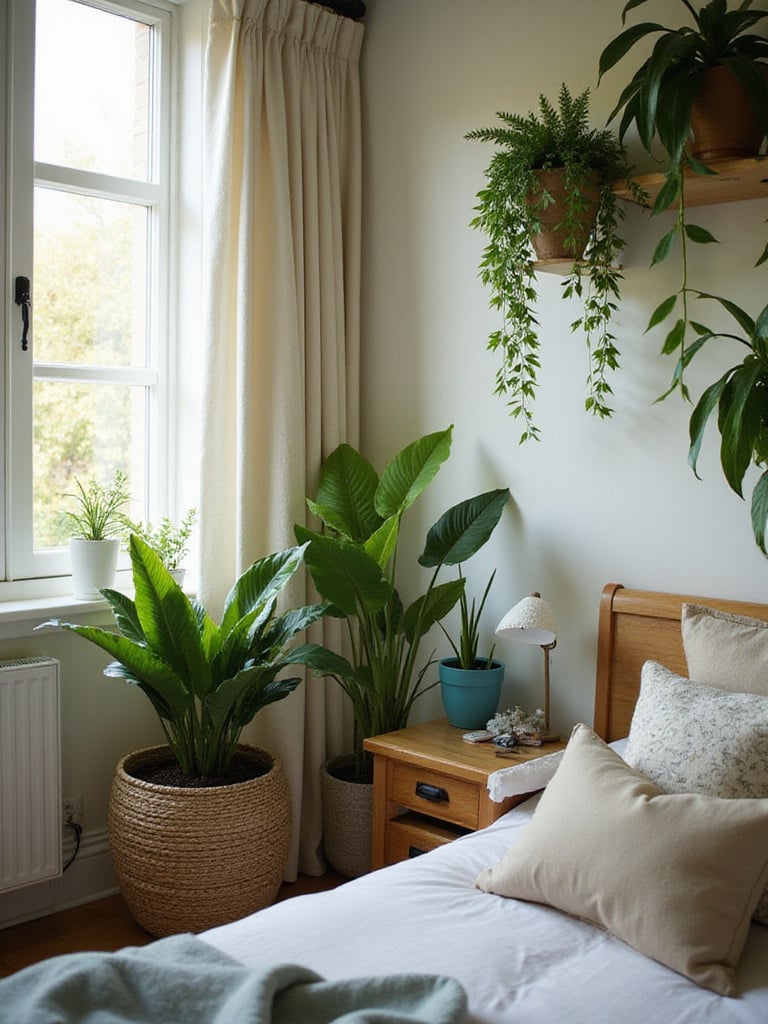
Layering is what provides true flexibility. A simple cellular shade, for instance, offers excellent insulation and light-blocking, but can feel a bit stark on its own. Pair it with soft, flowing linen curtains, and you have both high function and aesthetic beauty. Even the mounting hardware contributes to the overall feeling of quality and intention.
Choosing treatments made from sustainable materials and by responsible artisans adds a layer of integrity that you will feel every time you draw the curtains.
23. Add Subtle Architectural Interest
A plain, box-like room can be transformed by adding quiet architectural details. Things like graceful molding, a beautifully crafted built-in bookshelf, or even a subtle change in ceiling height over the bed can add a layer of character and sophistication. The key is that these additions should feel inherent to the room’s design, not like afterthoughts.
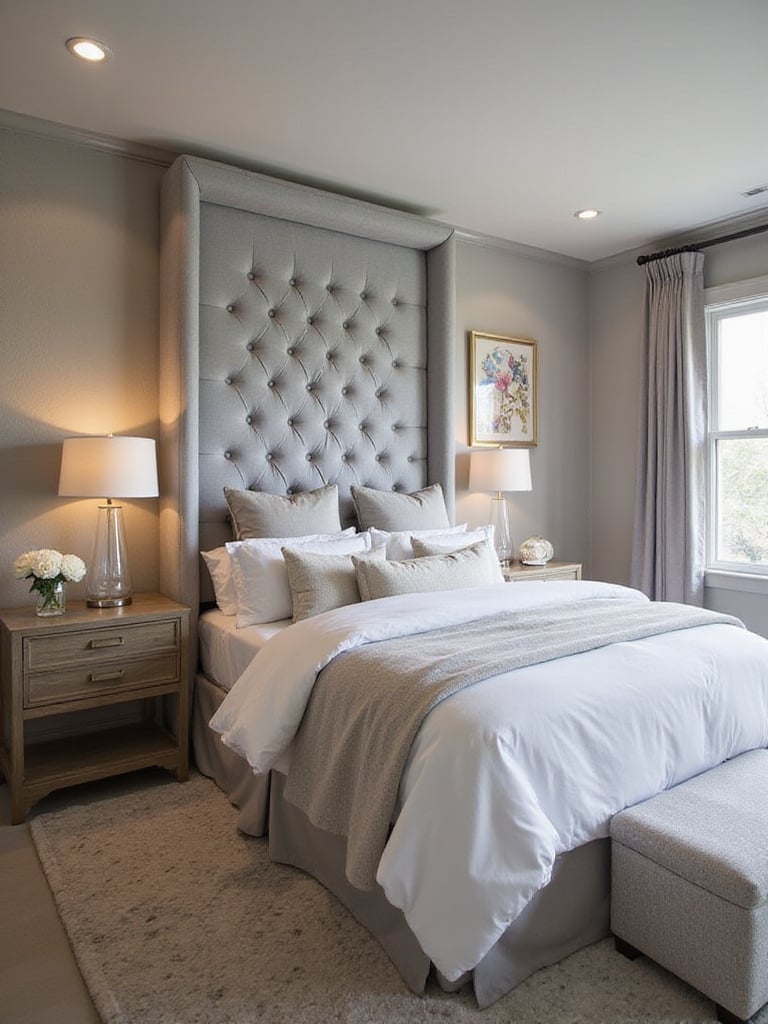
These details are most powerful when they interact with light, creating soft shadow lines that add depth and dimension to the space. Often, the most impactful details are the quietest ones—a perfectly proportioned baseboard or a beautifully joined corner. It is this attention to subtle detail, this shibui or understated elegance, that creates a room with lasting soul.
This is where heritage techniques, updated with a modern sense of proportion, can create something truly special.
24. Design for Your Future Self
A bedroom should have the grace to evolve with you. While your tastes and needs will undoubtedly change over time, the bones of the room can be designed for longevity. Foundational elements like the flooring, the lighting plan, and any built-in features should be chosen for their timeless quality and adaptability.
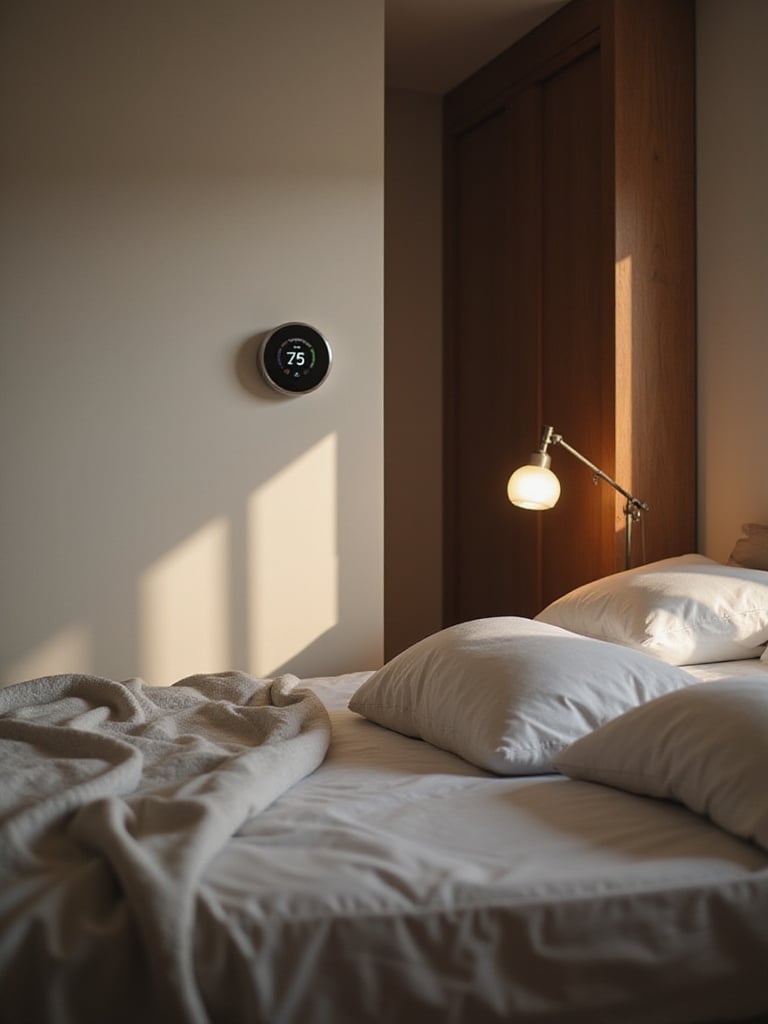
When you invest in a strong, simple foundation, you give yourself the freedom to change smaller things—furniture, textiles, art—as your life evolves, without needing to start from scratch. A thoughtfully designed room can adapt from being a single person’s retreat to a couple’s sanctuary, or even accommodate a small workspace in a new phase of life.
The most sustainable design recognizes that our lives are not static. It creates a space that can grow with us, maintaining its essential character as a place of peace.
Conclusion
To create a bedroom that is a true sanctuary is a slow, reflective process. It requires more than just following a list of ideas; it requires patience and a deep respect for the power of your environment. These principles, many rooted in a Japanese sensibility, all point toward one central idea: create a space that can breathe. A room where every object has purpose and meaning contributes to a profound sense of harmony.
This journey is an opportunity to reconnect with what truly nourishes you. By choosing natural materials that feel good to the touch, by shaping light to support your health, and by creating a sense of visual calm, you are doing more than decorating. You are building a foundation for deeper rest, less stress, and a more centered life.
As you begin, start with the elements you feel, not just the ones you see: the quality of the air, the support of your mattress, the nature of the light. Allow the room to transform gradually, with each choice made thoughtfully. This is how you create a bedroom that not only welcomes you home each night but sends you back into the world each morning feeling truly restored.
